Garmin 02567 Digital Transmission System 2412-2462 MHz User Manual 1
Garmin International Inc Digital Transmission System 2412-2462 MHz 1
Garmin >
Contents
- 1. User Manual 1
- 2. User Manual 2
User Manual 1
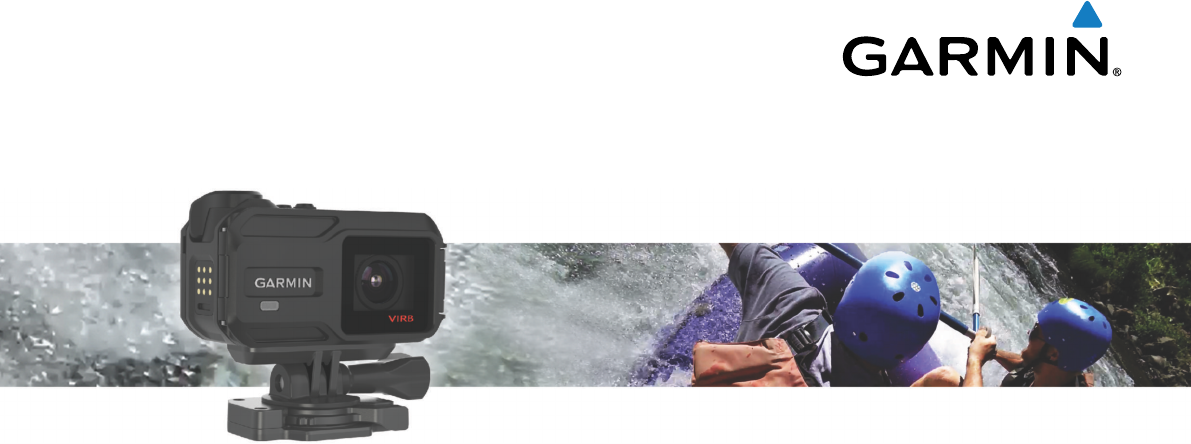
VIRB® X/XE
Owner’s Manual
May 2015 Printed in Taiwan 190-01870-00_0A
DRAFT
All rights reserved. Under the copyright laws, this manual may not be copied, in whole or in part, without the written consent of Garmin. Garmin reserves the
right to change or improve its products and to make changes in the content of this manual without obligation to notify any person or organization of such
changes or improvements. Go to www.garmin.com for current updates and supplemental information concerning the use of this product.
Garmin®, the Garmin logo, ANT+®, fēnix®, and VIRB® are trademarks of Garmin Ltd. or its subsidiaries, registered in the USA and other countries. G-Metrix™
is a
trademark of Garmin Ltd. or its subsidiaries. These trademarks may not be used without the express permission of Garmin.
The Bluetooth® word mark and logos are owned by the Bluetooth SIG, Inc. and any use of such marks by Garmin is under license. Mac® is a trademark of
Apple Inc., registered in the U.S. and other countries. microSD™
and the microSDXC logo are trademarks of SD-3C, LLC. Wi‑Fi® is a registered mark of Wi-Fi
Alliance Corporation. The Wi‑Fi® CERTIFIED logo is a certification mark of Wi-Fi Alliance Corporation. Windows® is a registered trademark of Microsoft
Corporation in the United States and other countries. Other trademarks and trade names are those of their respective owners.
This product is ANT+® certified. Visit www.thisisant.com/directory for a list of compatible products and apps.
DRAFT

Table of Contents
Introduction.....................................................................1
Opening the Front Cover............................................................ 1
Installing a Memory Card............................................................ 1
Installing the Desiccant Pack...................................................... 1
Installing the Battery................................................................... 1
Charging the Battery................................................................... 1
Saving Energy While Charging the Device............................ 2
Attaching the Device to the Mount.............................................. 2
Keys............................................................................................ 2
Turning On the Device................................................................ 2
Turning Off the Device........................................................... 2
Turning the Device On and Off Using the Recording
Switch.................................................................................... 2
Home Screen Overview.............................................................. 2
Viewing the Sensor Screens.................................................. 3
Status Bar Icons.....................................................................3
Sensor Status Icons............................................................... 3
Video................................................................................ 3
Recording a Video...................................................................... 3
Video Settings.............................................................................3
Video Modes.......................................................................... 3
Field of View Settings............................................................ 4
Setting the Video Format....................................................... 4
Pro Settings........................................................................... 4
Recording Video Automatically................................................... 4
Recording a Time-Lapse Video.................................................. 4
Recording a Video Loop............................................................. 4
Connecting a Cabled External Microphone or Audio Source..... 5
Live Viewfinder........................................................................... 5
Outputting Composite Video.................................................. 5
Photos............................................................................. 5
Taking a Photo............................................................................5
Photo Settings............................................................................ 5
Photo Modes.......................................................................... 5
Taking a Delayed Photo............................................................. 5
Taking Time-Lapse Photos......................................................... 5
G-Metrix........................................................................... 6
G-Metrix Overlays....................................................................... 6
ANT+ Sensors................................................................. 6
Pairing Your ANT+ Sensors....................................................... 6
Tips for Pairing ANT+ Accessories with Your Garmin
Device.................................................................................... 6
Removing Paired ANT+ Sensors........................................... 6
Bluetooth Devices.......................................................... 6
Connecting a Wireless External Microphone.............................. 6
Connecting an OBD-II Device.....................................................6
Removing Paired Bluetooth Devices.......................................... 7
Applications.................................................................... 7
Operating the Device Using Your Mobile Device....................... 7
Wi‑Fi Modes........................................................................... 7
Wireless Settings................................................................... 7
VIRB Edit.................................................................................... 7
Remote Control...............................................................7
Controlling the Device Remotely................................................ 7
Controlling Multiple VIRB Devices Remotely.............................. 7
Device Information......................................................... 7
System Settings.......................................................................... 7
Inverting the Camera Orientation........................................... 8
Time and Date Settings......................................................... 8
Erasing Your Memory Card........................................................ 8
Device Care................................................................................ 8
Cleaning the Device............................................................... 8
Connecting the Device to Your Computer.................................. 8
File Types.............................................................................. 8
Specifications..............................................................................8
Troubleshooting............................................................. 9
My device does not turn on.........................................................9
My device display is hard to see................................................. 9
Some data is missing from G-Metrix...........................................9
My video recordings do not look smooth.................................... 9
My device turns off when I stop recording video........................ 9
Extending the Battery Life.......................................................... 9
Getting More Information............................................................ 9
Appendix......................................................................... 9
Software License Agreement......................................................9
Symbol Definitions...................................................................... 9
Index.............................................................................. 10
Table of Contents i
DRAFT
DRAFT
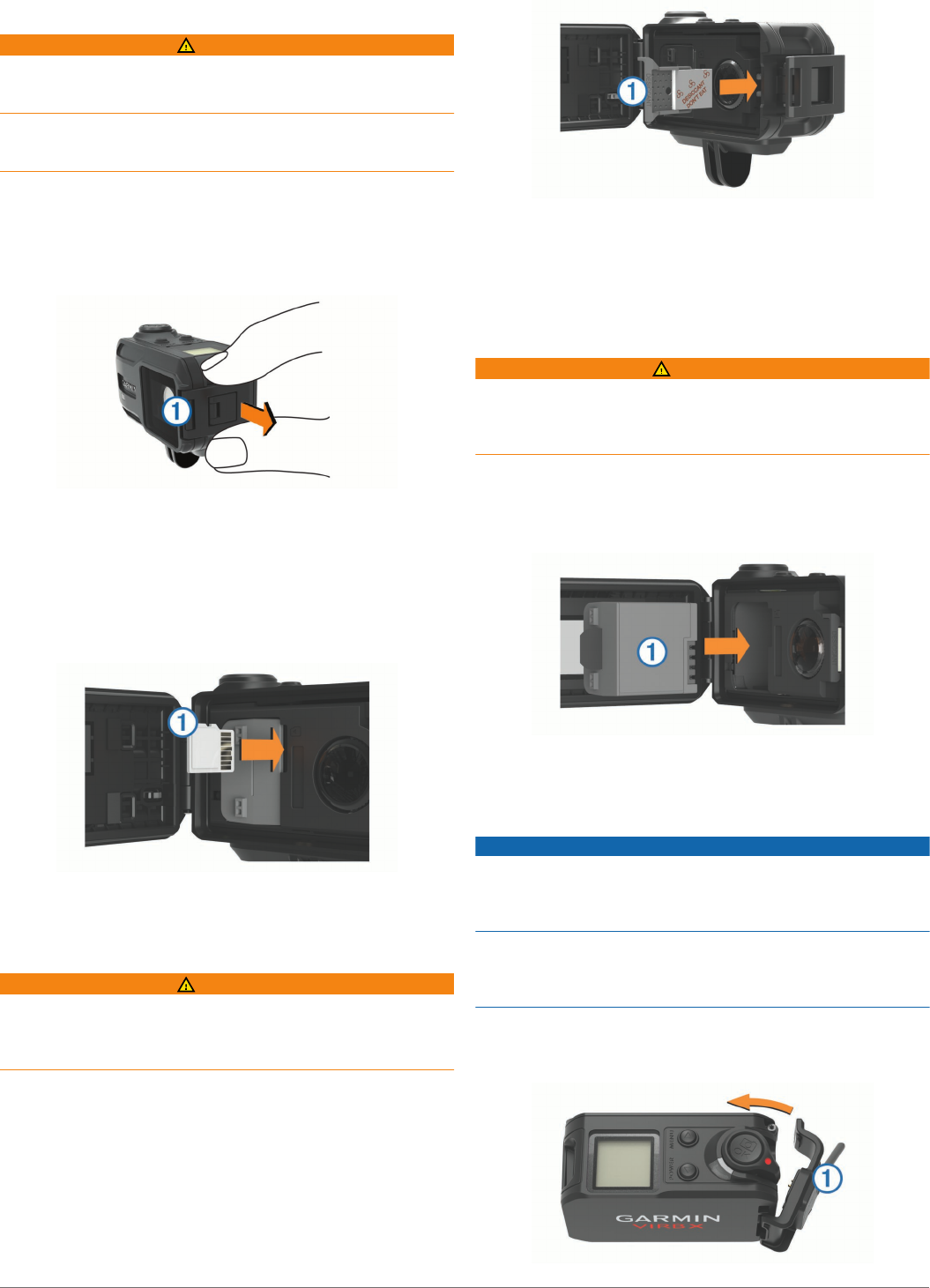
Introduction
WARNING
See the Important Safety and Product Information guide in the
product box for product warnings and other important
information.
It is your responsibility to use the device in a safe manner.
Garmin® will not be responsible for any property damage, injuries
or deaths resulting from any use of this device in any activities.
Opening the Front Cover
You must open the front cover to install the battery, memory
card, and anti-fog desiccant pack.
1Grip the top and bottom of the latch À and pull to open the
latch.
2Open the front cover.
Installing a Memory Card
You must install a microSD™
memory card to use your device.
For optimal performance, use a class 10 or better memory card.
1Open the front cover.
2Insert the memory card À into the memory card slot with the
contacts facing the lens.
3Press in the card until it clicks.
4Close and latch the front cover.
Installing the Desiccant Pack
WARNING
Do not eat desiccant packs. Desiccant packs contain silica,
which may cause irritation in your digestive system. Desiccant
packs are harmful if swallowed by an infant or pet due to
choking hazard.
You should install an anti-fog desiccant pack for optimal
performance and fog resistance.
1Open the front cover.
2Insert the desiccant pack into the desiccant tray À.
3Insert the desiccant tray into the desiccant slot.
4Close and latch the front cover.
The indicator dot on the desiccant pack turns pink when the
desiccant pack becomes saturated. Heat the desiccant pack at
85°C (185°F) for 60 minutes to dry the desiccant pack for reuse.
Installing the Battery
WARNING
This product contains a lithium-ion battery. To prevent the
possibility of personal injury or product damage caused by
battery exposure to extreme heat, store the device out of direct
sunlight.
1Open the front cover.
2Locate the metal contacts on the end of the lithium-ion
battery.
3Insert the battery À into the compartment, contacts first.
4Press the battery into place.
5Close and latch the front cover.
Charging the Battery
NOTICE
To prevent corrosion, thoroughly clean and dry the contacts and
the surrounding area on the side of the device before charging
or connecting to a computer. Refer to the cleaning instructions in
the appendix.
Do not attempt to use the device to charge a battery that was
not provided by Garmin. Attempting to charge a battery that was
not provided by Garmin can damage the device and void the
warranty.
1Plug the USB cable into a USB port on your computer.
2Align the charger posts with the contacts on the side of the
device, and press the charger À until it clicks.
Introduction 1
DRAFT
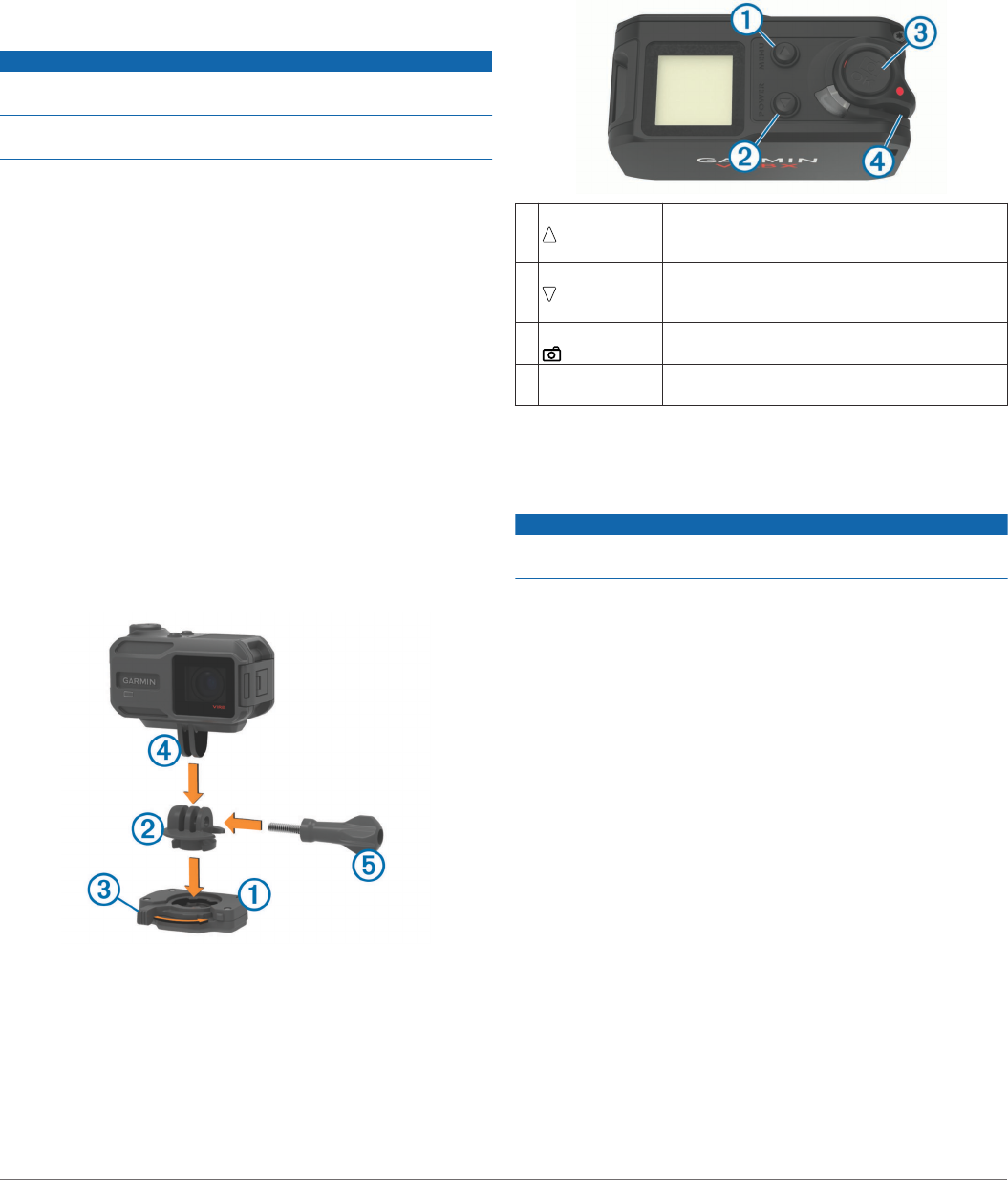
3Charge the battery completely.
Saving Energy While Charging the Device
You can turn off the device screen and all other features while
charging.
1Connect your device to an external power source.
2Hold POWER for 4 to 5 seconds.
The screen turns off, and the device goes into a low power,
battery charging mode.
3Charge the device completely.
Attaching the Device to the Mount
NOTICE
To prevent product loss or damage, do not use the adhesive
mounting base when the temperature is below -15°C (5°F).
The permanent mounting adhesive is extremely difficult to
remove after it is installed.
Before you can install the adhesive mounting base onto a
surface, the ambient temperature must be from 21° to 38°C
(from 70° to 100°F).
Your device includes an assortment of mounting bases and
arms, which can be used in many configurations. These
instructions provide an example of one possible configuration.
You can also purchase additional mounts for your device, such
as wearable mounts, vehicle mounts, or a tripod mount. Go to
www.garmin.com/VIRB for more information.
NOTE: By default, the device should be mounted with the
screen facing up to record correctly oriented video. You can
adjust the settings to record with the screen facing down
(Inverting the Camera Orientation).
1Thoroughly clean and dry the mounting surface using water
or alcohol.
The mounting surface must be free of dirt, debris, wax, or
coatings.
2Remove the film from the adhesive mounting base À, and
press the base firmly onto the mounting surface.
You can use either the flat base or the curved base,
depending on the contour of the mounting surface.
3Allow the base to bond to the mounting surface for at least 24
hours.
4Insert the adapter Á into the base.
The lever  must be in the open position.
5Snap the lever to the closed position to lock the adapter into
the base.
The lever should be flush with the base.
6Insert the camera mount à into the top of the adapter.
The device should be horizontal for the proper aspect ratio
when recording video.
7Insert a thumbscrew Ä into the larger opening of the joint,
and tighten the thumbscrew to lock the angle of the joint.
NOTE: The metal fitting indicates the smaller opening of the
joint.
8If necessary, insert the included hex wrench into the end of
the thumbscrew to adjust the tightness of the joint.
Keys
ÀMENU Select to scroll through sensor status screens,
data screens, and menu items.
Hold to open the menu.
ÁPOWER Select to scroll through sensor status screens,
data screens, and menu items.
Hold to turn the device on or off.
ÂOK Select to choose menu options or to take a photo.
ÃRecording
switch
Move the switch to start or stop recording video.
Turning On the Device
Select POWER.
Turning Off the Device
NOTICE
To prevent loss of data, always turn off the device before
removing the battery.
NOTE: You cannot turn off the device while recording video.
1If necessary, move the recording switch backward to stop
recording video.
2Hold POWER.
The device saves your data and turns off.
If you need to remove the battery, wait until the screen and the
recording light turns off before removing the battery.
Turning the Device On and Off Using the Recording
Switch
You can use the recording switch to turn the device on and off in
recording mode. This feature allows you to start recording
quickly, while automatically turning off the device to conserve
battery power when you are not recording.
NOTE: The device does not turn off using the recording switch
unless you use the recording switch to turn on the device.
1With the device turned off, move the recording switch
forward.
The device turns on and starts recording video.
2When you are finished recording, move the recording switch
backward.
The device stops recording and turns off.
Home Screen Overview
The home screen provides at-a-glance details about the
remaining memory card space and current settings of your
device.
2 Introduction
DRAFT
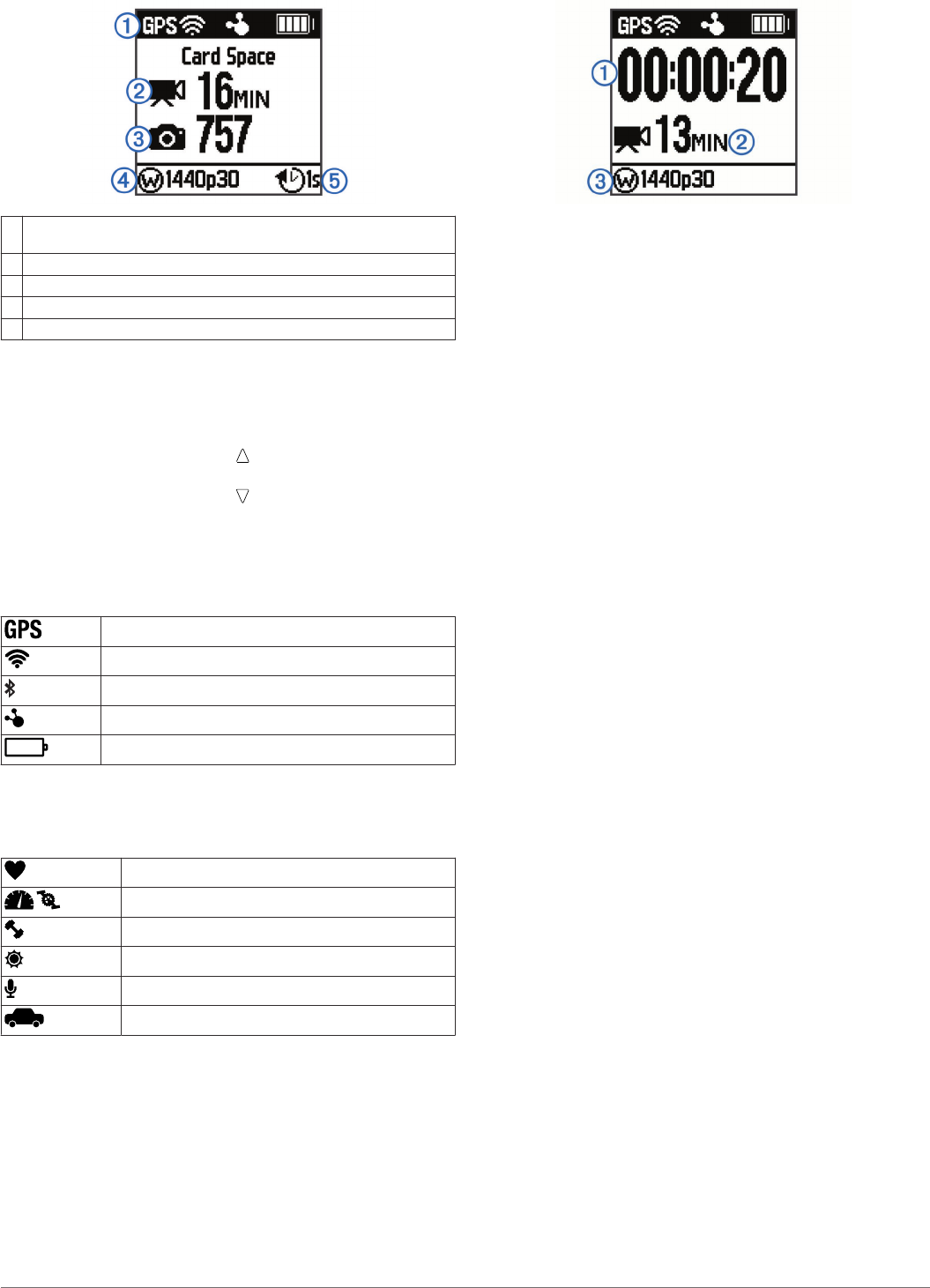
ÀDisplays the sensor status and remaining battery capacity. Includes
ANT+® sensors, Bluetooth®, Wi‑Fi®, and GPS.
ÁDisplays the remaining memory card space for video recording.
ÂDisplays the remaining memory card space for photos.
ÃDisplays the field of view, video resolution, and frame rate.
ÄDisplays the photo mode.
Viewing the Sensor Screens
The sensor screens display G-Metrix™
data from built-in sensors,
and data from paired ANT+ sensors. The sensor status screen
displays the connection status for ANT+ sensors, Wi‑Fi
connection, and Bluetooth devices.
• From the home screen, select to view the sensor status
screen.
• From the home screen, select to view the sensor data
screens.
Status Bar Icons
Icons appear at the top of the home screen. A flashing icon
means the device is searching for a signal. A solid icon means
the signal was found or the sensor is connected.
GPS status
Wi‑Fi technology status
Bluetooth technology status
ANT+ sensor status
Battery level
Sensor Status Icons
Icons appear on the sensor status screen. A flashing icon
means the device is searching for a signal. A solid icon means
the signal was found or the sensor is connected.
Heart rate status
Speed and cadence status
Power status
Temperature status
Headset and audio status
OBD-II status
Video
Recording a Video
NOTE: If the battery power becomes very low while recording
video, the device automatically stops recording, saves the video,
and safely turns off.
1Move the recording switch forward to start recording video.
If the device is off, it turns on automatically. The device starts
recording video immediately, and the red light turns on.
The screen displays the elapsed recording time À, available
recording time Á, and video mode Â.
2Move the recording switch backward to stop recording video.
The video is saved on the memory card as an .mp4 file. The
track log for the video and sensor data is saved on the
memory card as a .fit file.
Video Settings
Hold MENU, and select Video.
Mode: Sets the video shooting mode (Video Modes).
NOTE: Additional settings vary based on the selected mode.
Resolution: Sets the height of the video, in pixels.
Interval: Sets the time interval for time-lapse mode.
FPS: Sets the frame rate in frames per second (fps).
Field of View: Sets the zoom level (Field of View Settings).
Playback: Sets the speed for slow-motion playback.
Lens Correct: Corrects wide-angle barrel distortion and reduces
the field of view.
Light Boost: Enables automatic adjustment for low light.
Stabilizer: Turns on image stabilization to reduce shaky video.
NOTE: Image stabilization is available for the VIRB XE
device only.
Loop: Enables loop recording and sets the number of minutes
of video to store when recording a video loop (Recording a
Video Loop).
Auto Record: Enables automatic recording when the device is
in motion (Recording Video Automatically).
Video Out: Enables composite video output (Outputting
Composite Video).
Pro Settings: Enables advanced video and photo settings (Pro
Settings).
NOTE: Pro settings are available for the VIRB XE device
only.
Video Modes
You can change the video mode to change the resolution,
aspect ratio, frame rate, and speed of recorded video. The
resolution is the width and height of the video, in pixels. The
aspect ratio is the ratio of the video width to the video height.
Standard widescreen televisions use a 16:9 aspect ratio, and
standard full-screen televisions use a 4:3 aspect ratio. The
frame rate is expressed in frames per second (fps). The
playback speed indicates the speed of action in the video
compared to real time.
Hold MENU, and select Video > Mode.
Tall: Enables you to capture a large, vertical viewing area using
a 4:3 aspect ratio. This mode is particularly useful for close-
up action shots and when using a chest mount.
HD Video: Enables you to capture high-speed action shots.
1080p works well as a default setting when you need high-
resolution shots.
Slow-Mo: Enables you to capture slow-motion playback in 720p
HD or widescreen standard definition.
Video 3
DRAFT

Timelapse: This high-resolution mode enables you to capture
slow-moving or long-term action that is ready for playback or
sharing immediately (Recording a Time-Lapse Video).
VIRB XE Video Mode Specifications
Mode Resolution (pixels) Aspect Ratio NTSC Frame Rate (fps) PAL Frame Rate (fps) Field of View (fov) Speed
Tall 1440p (1920x1440) 4:3 30, 24 25, 24 Wide 1x
960p (1280x960) 4:3 100, 60, 48 100, 50, 48 Wide 1x
HD Video 1080p (1920x1080) 16:9 60, 48, 30, 24 50, 48, 25, 24 Wide, zoom, ultra zoom 1x
720p (1280×720) 16:9 120, 60, 30 100, 50, 25 Wide, zoom, ultra zoom 1x
Slow-Mo 720p (1280×720) 16:9 120 100 Wide, zoom, ultra zoom 1x, 1/4x, 1/2x
480p (848x480) 16:9 240 240 Wide 1x, 1/8x, 1/4x, 1/2x
Timelapse 1080p (1920×1080) 16:9 30 25 Wide, zoom, ultra zoom Varies
VIRB X Video Mode Specifications
Mode Resolution (pixels) Aspect Ratio NTSC Frame Rate (fps) PAL Frame Rate (fps) Field of View (fov) Speed
Tall 960p (1280x960) 4:3 30 25 Wide 1x
HD Video 1080p (1920x1080) 16:9 30 25 Wide, zoom, ultra zoom 1x
720p (1280×720) 16:9 60, 30 50, 25 Wide, zoom, ultra zoom 1x
Slow-Mo 720p (1280×720) 16:9 60 50 Wide, zoom, ultra zoom 1x, 1/2x
480p (848x480) 16:9 120 100 Wide 1x, 1/4x, 1/2x
Timelapse 1080p (1920×1080) 16:9 30 25 Wide, zoom, ultra zoom Varies
Field of View Settings
You can change the field of view when Lens Correct is set to
Off.
Hold MENU, and select Video > Field of View.
Wide: Captures a wide view of your surroundings. Use this
option for open areas, close-range video, and to capture as
much of your viewing area as possible.
Zoom: Captures a tighter view. Use this option for medium-
range video.
Ultra-Zoom: Captures a very focused view. Use this option for
long-range video and closed or covered surroundings.
Setting the Video Format
You can set the video standard for your region. The video
standard affects the available video frame rate options (FPS).
1Hold MENU.
2Select System > Format.
3Select NTSC or PAL.
Pro Settings
Hold MENU, and select Video > Pro Settings > Status.
TIP: While on the home screen, you can select to view the
current pro settings.
NOTE: Pro settings are available for the VIRB XE device only.
Color: Sets the color palette. You can use the Vivid option for a
more vibrant color palette, or the Flat option for a more
neutral color palette.
White Bal.: Adjusts the color tone based on your surroundings.
The device can automatically adjust the white balance, or you
can manually adjust the white balance. You can use the
2800K option for incandescent light, the 4000K option for
fluorescent light, the 5000K option for daylight, the 6500K
option for sunny conditions, or the 7500K option for cloudy
conditions.
Sharpness: Sets the level of sharpness. You can use the High
option for a sharper look, the Medium option for moderate
sharpness, or the Low option for a softer look.
ISO Limit: Sets the level of sensitivity and image noise. Higher
ISO values have more visible noise or grain. Higher ISO
values are best for use in low light environments or indoors.
Lower ISO values are best for use in sunlight. You can use
the 6400 option for brighter video in low light, the 1600 option
for moderate brightness in low light, or the 400 option for
darker video in low light.
EV Bias: Sets the exposure bias. Exposure bias affects the level
of brightness.
EV Lock: Enables or disables exposure lock. You can enable
exposure lock to ensure consistent light sensitivity in your
video capture. When recording a time-lapse video, this helps
eliminate stray frames with slightly brighter or darker images.
Recording Video Automatically
You can set the device to record video automatically when the
device is moving. This feature allows you to conserve space on
your memory card by recording only the important parts of your
activity.
1Hold MENU.
2Select Video > Auto Record > When Moving.
The device records video when you are moving and stops
recording when you are still.
This feature automatically enables GPS in the system settings.
Recording a Time-Lapse Video
Time-lapse mode captures individual video frames at longer
intervals and creates a video that plays much faster than real
time. You can use time-lapse mode to record movements,
changes, or events that take place over a long period of time.
Time-lapse videos play at 30 frames per second. The length of
the video depends on the amount of time between video
frames. For example, if frames are recorded at a one-second
interval, each second of video covers 30 seconds of real time. If
frames are recorded at a 60-second interval, each second of
video covers 30 minutes of real time.
1Hold MENU.
2Select Video > Mode > Timelapse.
3Select a time interval.
4For the best results, mount the device so it does not move
while recording.
5Record a video.
Recording a Video Loop
Loop recording allows you to record video continuously but save
only the most recent video footage. You can select the number
4 Video
DRAFT

of minutes of video to save. This enables you to save storage
space when you want to capture key moments but do not want
to save all footage of an activity. This feature is useful when
using the device as a driving recorder.
The saved video loop is split into multiple files of equal length.
This allows you to delete unwanted portions of the video easily.
1Hold MENU.
2Select Video > Loop.
3Select the number of minutes of video to save.
4Start recording video.
5When finished, stop recording.
The most recent footage is saved on the memory card, up to the
number of minutes selected in step 3.
Connecting a Cabled External Microphone or
Audio Source
Before you can connect an external microphone, you must
purchase the VIRB rugged combo cable accessory. Go to
http://virb.garmin.com/products/rugged-combo-cable-virbx-xe.
You must also have an external microphone or audio source
with a 3.5 mm connector.
When you enable and connect an external microphone, the
device records audio from the external microphone instead of
the built-in microphone.
1Hold MENU.
2Select System > Microphone > External to enable the
external microphone.
3Align the charger posts on the accessory cable with the
contacts on the side of the device, and press the accessory
cable until it clicks.
4Connect the microphone to the MIC IN connector on the
accessory cable.
To stop using the external microphone, you must disconnect the
accessory cable from the device. You can select System >
Microphone > Internal to enable the built-in microphone.
Live Viewfinder
Outputting Composite Video
Before you can output composite video, you must purchase the
VIRB rugged combo cable accessory. Go to
http://virb.garmin.com/products/rugged-combo-cable-virbx-xe.
You must also have an RCA composite video cable.
You can display composite video on an external display.
1Hold MENU.
2Select Video > Video Out to enable composite video output.
3Align the charger posts on the accessory cable with the
contacts on the side of the device, and press the accessory
cable until it clicks.
4Connect an RCA composite video cable to the VID OUT
connector of the accessory cable and to an available port on
your external display.
Photos
Taking a Photo
Your device provides several methods for taking a photo using
the default settings. You can change the photo mode to capture
single, burst, or time lapse photos by holding MENU and
selecting Photos > Mode.
• While on the home screen or sensor screens, select the
key to take a single photo.
• While on the home screen or sensor screens, hold the key
to take multiple photos in burst-on-demand mode.
The device continues taking photos the entire time you hold
.
• While recording a video, select the key to capture a photo
at the same resolution as the video recording.
Photos taken while recording a video always use single photo
capture. Photo timelapse or burst settings are ignored while
recording video.
Photo Settings
Hold MENU, and select Photos.
Mode: Sets the shooting mode (Photo Modes).
NOTE: Additional settings vary based on the selected mode.
Start Time: Sets the start time for extended time-lapse mode.
You can start shooting now, or set a custom start time.
Duration: Sets the duration for extended time-lapse mode. You
can shoot continuously, or set a custom duration.
Interval: Sets the time interval for burst mode, time-lapse mode,
and extended time-lapse mode. For time-lapse mode, you
can choose a preset interval or set a custom interval.
Field of View: Sets the zoom level.
Self Timer: Sets the timer to delay taking a photo.
Lens Correct: Corrects wide-angle barrel distortion and reduces
the field of view.
Date Stamp: Adds a date stamp to your photo.
Photo Modes
Hold MENU, and select Photos > Mode.
Single: Enables you to take a single photo using automatic
exposure.
Burst: Enables you to rapidly take three, five, or ten images in
one second. This mode is ideal for capturing photos of
people or objects in motion.
NOTE: The VIRB XE device provides additional burst
intervals.
Timelapse: Enables you to capture a series of photos at set
time intervals.
Ext. Timelapse: Enables you to capture a series of photos over
an extended duration. The VIRB X/XE device turns off
between image captures, allowing the device to maximize
battery life.
Taking a Delayed Photo
You can delay taking a photo using the self timer. This allows
you to join or adjust a shot before the photo is taken.
1Hold .
2Select Photos > Self Timer.
3Select a delay time.
4While on the home screen, select the key.
The countdown timer displays the remaining time until the
photo is taken, in seconds.
Taking Time-Lapse Photos
You can use the time-lapse or extended time-lapse mode to
take a series of photos at a set time interval.
1Hold MENU.
2Select Photos > Mode.
3Select Timelapse or Ext. Timelapse.
4If using extended time-lapse mode, select a start time and
duration for the shoot.
5Select a time interval between photos.
Photos 5
DRAFT

6While on the home screen, select the key.
The device takes a series of photos at the selected interval.
The screen displays the remaining number of photos the
device can take À, the number of photos the device has
taken Á, the elapsed time Â, and the time in seconds until
the next photo is taken Ã.
7Select to stop taking photos.
G-Metrix
Your VIRB X/XE device contains built-in GPS, G-force, and
orientation sensors. Your device can also wirelessly connect to
external ANT+ sensors and other Garmin devices to capture
even more performance data. You can use the free Garmin
VIRB mobile app or VIRB Edit software application to overlay
gauges, graphs, and more. You can then play back your
recorded video to show your speed, acceleration, heart rate, and
other sensor data in real time.
G-Metrix Overlays
Your device can record these types of data.
• Speed
• Pace
• Altitude
• G-force
• Orientation
• Hang time
• Distance
• Grade
• Pitch
• Roll
• Bearing (when moving)
• GPS location (coordinates)
• Track shape and position
• Lap times
• Lap count
• Heart rate (when connected to a compatible heart rate
monitor)
• Cadence (when connected to a compatible bicycle cadence
sensor)
• Power output in watts (when connected to a compatible
power meter)
• Temperature (when connected to a compatible temperature
sensor)
• Automotive data (when connected to a compatible OBD-II
device)
ANT+ Sensors
Your device can be used with wireless ANT+ sensors. For more
information about compatibility and purchasing optional sensors,
go to http://buy.garmin.com.
Pairing Your ANT+ Sensors
When you pair a compatible ANT+ sensor with your device, the
sensor data is included in the G-Metrix overlays and in the .fit
file.
1Put on the heart rate monitor or install the sensor.
2Bring the device within 3 m (10 ft.) of the sensor.
3Hold MENU.
4Select Sensors > Add New.
5Select an option:
• Select Search All.
• Select your sensor type.
6Select the sensor to pair.
After the sensor is paired with your device, the sensor status
changes to Connected.
While on the home screen, you can select to view sensor
data.
Tips for Pairing ANT+ Accessories with Your Garmin
Device
• Verify that the ANT+ accessory is compatible with your
Garmin device.
• Before you pair the ANT+ accessory with your Garmin
device, move 10 m (32.9 ft.) away from other ANT+
accessories.
• Bring the Garmin device within range 3 m (10 ft.) of the ANT+
accessory.
• After you pair the first time, your Garmin device automatically
recognizes the ANT+ accessory each time it is activated. This
process occurs automatically when you turn on the Garmin
device and only takes a few seconds when the accessories
are activated and functioning correctly.
• When paired, your Garmin device receives data from only
your accessory, and you can go near other accessories.
Removing Paired ANT+ Sensors
1Hold MENU.
2Select Sensors.
3Select a sensor.
4Select Remove > Yes.
Bluetooth Devices
Connecting a Wireless External Microphone
You can connect a Bluetooth hands-free device with your VIRB
X/XE device.
1Hold MENU.
2Select Bluetooth > Status to turn on Bluetooth wireless
technology.
3Select Add New.
4Select the wireless device to pair.
After the wireless device is paired, the device status changes
to Connected.
Connecting an OBD-II Device
Your VIRB X/XE device can pair with a compatible Bluetooth
ELM327 on-board diagnostics (ODB-II) device to record
automotive data from your OBD-II compliant vehicle.
6 G-Metrix
DRAFT

1Install your ELM327 compatible OBD-II device in the OBD-II
port of your vehicle.
TIP: See the owner's manual for your vehicle to locate the
OBD-II port.
2If necessary, enable pairing mode on your OBD-II device.
TIP: See the owner's manual for your OBD-II device to
enable pairing mode.
3From the VIRB X/XE device, hold MENU.
4Select Bluetooth > Status to turn on Bluetooth wireless
technology.
5Select Add New.
6Select the OBD-II device to pair.
TIP: If your OBD-II device does not appear in the list, confirm
that it is still in pairing mode and search again.
After the OBD-II device is paired, the device status changes
to Connected.
Removing Paired Bluetooth Devices
1Hold MENU.
2Select Bluetooth.
3Select a wireless device.
4Select Forget > Yes.
Applications
Operating the Device Using Your Mobile
Device
The free Garmin VIRB app lets you remotely view and control
photo and video recording using a compatible mobile device.
You can view playback of recorded clips and photos, as well as
create, edit, and share videos on social media. Go to
http://virb.garmin.com/virb-app for more information.
1Install the Garmin VIRB app from the application store on
your mobile device.
2On your VIRB device, hold MENU, and select Wi-Fi > Status
to turn on Wi‑Fi wireless technology.
3On your mobile device, start the Garmin VIRB app.
4Follow the on-screen instructions.
Wi‑Fi Modes
Hold MENU, and select Wi-Fi.
Live Stream: Enables you to stream live video using your
mobile device.
Multi-Cam: Enables you to create or join a wireless network for
multiple cameras.
Mobile App: Enables you to operate the device using your
mobile device.
Join: Enables you to connect to a wireless network.
Wireless Settings
You can change the wireless host settings for your device.
Hold MENU, and select Wi-Fi > Edit.
SSID: Sets the SSID, which identifies your VIRB device on other
devices.
Password: Sets the password used to connect to your VIRB
device.
VIRB Edit
The VIRB Edit application provides easy access to these tools
and services for your device.
• Review and edit recorded videos
• Add G-Metrix gauges, graphs, and more
• Add titles and transitions
• Multi-camera support
• Update software and features
The VIRB Edit application is available for Windows® and Mac®
computers. Go to http://virb.garmin.com/virb-edit for more
information.
Remote Control
You can start recording, stop recording, and take pictures on
your VIRB device using another compatible Garmin device with
ANT+ wireless technology, such as the VIRB remote control
accessory or the fēnix® 3 watch. You can also use your VIRB
device to control other VIRB devices.
Controlling the Device Remotely
1On your VIRB device, hold MENU.
2Select Remote > On.
3Select Yes if you have more than one VIRB device.
4If necessary, select VIRB Type > Main VIRB.
5Select an option:
• On the remote control device, launch the VIRB app or
feature. See the owner's manual for the device for more
information.
• On the remote control accessory, follow the pairing
instructions in the accessory manual.
6On your VIRB device, select Remote Wake Up to keep the
device in a lower-power state (optional).
NOTE: The Remote Wake Up setting allows your remote
control to turn the device on, start recording, stop recording,
and turn the device off. While in a lower-power state, the
VIRB device appears to be off, but it continues to slowly
reduce battery life.
Controlling Multiple VIRB Devices Remotely
When controlling multiple VIRB devices with ANT+ wireless
technology, you must choose a main VIRB device. This device
controls all of your other VIRB devices.
When you use a remote control device with multiple VIRB
devices, the remote control device controls only the main VIRB
device. The main VIRB device passes commands received from
the remote control device to the other VIRB devices.
1On all of your VIRB devices, hold MENU, and select Remote
> On.
2On your main VIRB device, select VIRB Type > Main VIRB.
3On each of your other VIRB devices, select VIRB Type >
Extended VIRB.
The recording switch on your main VIRB device starts and
stops recording video on all of your VIRB devices. Selecting
the key on your main VIRB device takes a photo from all
of your VIRB devices.
4On the remote control accessory, follow the pairing
instructions in the accessory manual.
Device Information
System Settings
Hold MENU, and select System.
GPS: Enables the device to receive GPS satellite signals.
NOTE: The GPS setting must be set to On to enable Auto
Record.
Applications 7
DRAFT
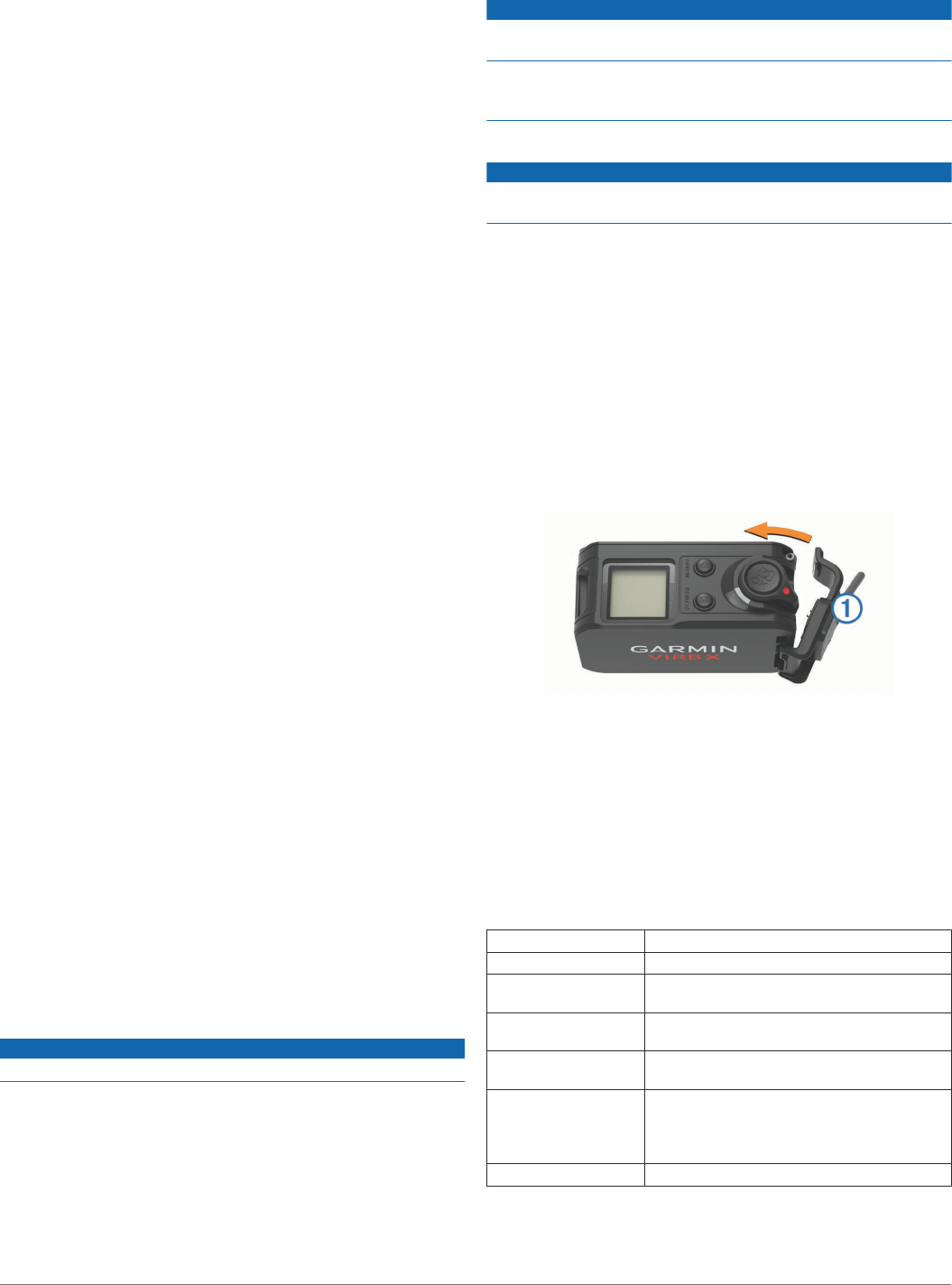
Orientation: Sets the camera to capture correctly oriented video
and photos with the screen facing up or down (Inverting the
Camera Orientation).
Microphone: Enables the internal or external microphone.
TIP: If wind noise is an issue when recording video, you can
select Off to record video without audio.
Record Light: Turns the recording light on or off.
Tones: Turns audible tones on or off.
Time/Date: Sets the time and date formats.
Units: Sets the units of measure.
Language: Sets the on-screen text language.
Format: Sets the video standard (Setting the Video Format).
Auto Off: Turns off the device automatically when the device
has not been used for five minutes.
Reset Settings: Restores the default device settings.
About: Displays important software information and your unit ID.
Inverting the Camera Orientation
You can change the camera orientation of your device to easily
access the keys during an activity. Some mounting
configurations require you to change the camera orientation. For
example, if using a chest mount while cycling, you can mount
the camera upside down and tilt it upward to compensate for
forward lean.
1Hold MENU.
2Select System > Orientation.
3Select an option:
• To automatically adjust the camera orientation, select
Auto.
NOTE: After recording starts, the camera orientation is set
and cannot be automatically adjusted.
• To manually adjust the camera orientation with the screen
facing upward, select This Side Up.
• To manually adjust the camera orientation with the screen
facing downward, select This Side Dn.
Time and Date Settings
Hold MENU, and select System > Time/Date.
Time Format: Sets the device to show time in a 12-hour or a
24-hour format.
Date Format: Sets the device to show dates in a MM/DD/YY or
a DD/MM/YY format.
Time: Sets the time manually or automatically based on your
GPS position.
Time Zone: Sets the time zone for the device. When you set the
time automatically, the time zone is set based on your GPS
position.
Day. Saving: Indicates whether daylight saving time is observed
in your region. The Automatic option sets daylight saving
automatically based on your GPS position.
Erasing Your Memory Card
NOTICE
Erased data cannot be restored.
You can erase all photos, videos, and other data on the memory
card installed in your device.
1Hold MENU.
2Select Card > Erase.
Device Care
NOTICE
Avoid chemical cleaners, solvents, and insect repellents that can
damage plastic components and finishes.
Do not store the device where prolonged exposure to extreme
temperatures can occur, because it can cause permanent
damage.
Cleaning the Device
NOTICE
Do not use a dry cloth to clean the lens. Use of a dry cloth may
damage the fog-resistant coating on the lens.
1Wipe the outer casing of the device with a soft, non-scratch
cloth dampened with water or alcohol.
2Open the front cover, and wipe the lens and lens cover with a
soft, non-scratch cloth dampened with water or alcohol.
NOTE: Do not damage or lose the O-ring gasket.
3Wipe the device dry.
Connecting the Device to Your Computer
Before you can connect the device to your computer, you may
need to remove optional mount accessories.
1Plug the USB cable into a USB port on your computer.
2Align the charger posts with the contacts on the side of the
device, and press the charger À until it clicks.
Your device and memory card appear as removable drives in
My Computer on Windows computers and as mounted
volumes on Mac computers.
File Types
The device supports these file types.
• .jpeg photo files.
• .mp4 video files.
• .fit files.
Specifications
Battery type Rechargeable lithium-ion battery
Battery life Up to 2 hr.
Operating temperature
range
From -20º to 45ºC (from -4º to 113ºF)
Charging temperature
range
From 0º to 45°C (from 32º to 113°F)
Storage temperature
range
From -40º to 85ºC (from -40º to 185ºF)
Radio frequency/
protocol
2.4 GHz ANT+ wireless communications
protocol
Wi‑Fi IEEE 802.11b/g/n at 2.4 GHz
2.4 GHz Bluetooth 4.0
Waterproof 50 m
8 Device Information
DRAFT

Troubleshooting
My device does not turn on
• Verify the battery is installed correctly (Installing the Battery).
• Fully charge the battery (Charging the Battery).
My device display is hard to see
The device has a reflective display that maximizes battery life
and is readable in direct sunlight. The display does not have a
backlight and requires ambient light for visibility. If the display
looks dark or hard to see, you should increase the ambient light
or go to a brighter area.
Some data is missing from G-Metrix
Some G-Metrix data requires you to enable or pair sensors.
• Enable GPS (System Settings), and go to an area with a
clear view of the sky.
Location, speed, distance, and altitude data require a GPS
signal.
• Connect additional ANT+ sensors (Pairing Your ANT+
Sensors).
Some data is available only when a compatible ANT+ sensor
is connected.
My video recordings do not look smooth
• If video recordings appear shaky, hold MENU, and select
Video > Stabilizer to enable image stabilization.
• If video recordings stutter or skip frames, install a Class 10 or
better microSD memory card (Installing a Memory Card).
The device requires a Class 10 or better memory card to
record smooth high-definition video.
My device turns off when I stop recording
video
If you turn on the device by moving the recording switch forward,
the device turns off when you move the recording switch
backward. This allows you to maximize battery life by turning off
the device when it is not recording (Turning the Device On and
Off Using the Recording Switch).
Extending the Battery Life
• Disable Wi‑Fi.
• Enable Auto Off in the system settings (System Settings).
• Turn the device on and off using the recording switch
(Turning the Device On and Off Using the Recording Switch).
• Use automatic recording (Video Settings).
• Disable ANT+ and Wi‑Fi Remote Wake Up when not in use.
Getting More Information
You can find more information about this product on the Garmin
website.
• Go to www.garmin.com/outdoor.
• Go to http://buy.garmin.com, or contact your Garmin dealer
for information about optional accessories and replacement
parts.
Appendix
Software License Agreement
BY USING THE DEVICE, YOU AGREE TO BE BOUND BY THE
TERMS AND CONDITIONS OF THE FOLLOWING SOFTWARE
LICENSE AGREEMENT. PLEASE READ THIS AGREEMENT
CAREFULLY.
Garmin Ltd. and its subsidiaries (“Garmin”) grant you a limited
license to use the software embedded in this device (the
“Software”) in binary executable form in the normal operation of
the product. Title, ownership rights, and intellectual property
rights in and to the Software remain in Garmin and/or its third-
party providers.
You acknowledge that the Software is the property of Garmin
and/or its third-party providers and is protected under the United
States of America copyright laws and international copyright
treaties. You further acknowledge that the structure,
organization, and code of the Software, for which source code is
not provided, are valuable trade secrets of Garmin and/or its
third-party providers and that the Software in source code form
remains a valuable trade secret of Garmin and/or its third-party
providers. You agree not to decompile, disassemble, modify,
reverse assemble, reverse engineer, or reduce to human
readable form the Software or any part thereof or create any
derivative works based on the Software. You agree not to export
or re-export the Software to any country in violation of the export
control laws of the United States of America or the export control
laws of any other applicable country.
Symbol Definitions
These symbols may appear on the device or accessory labels.
WEEE disposal and recycling symbol. The WEEE symbol is
attached to the product in compliance with the EU directive
2002/96/EC on Waste Electrical and Electronic Equipment
(WEEE). It is intended to deter the improper disposal of this
product and to promote reuse and recycling.
Troubleshooting 9
DRAFT

Index
A
accessories 6, 9
ANT+ sensors 2, 3, 6
forgetting 6
pairing 6
B
battery 7, 8
charging 1, 2
installing 1
life 9
Bluetooth technology 3, 6, 7
C
cadence 6
camera
field of view 4
orientation 8
self timer 5
settings 2, 5
charging 1, 2
cleaning the device 8
computer, connecting 8
D
data, transferring 8
deleting, all user data 8
E
elevation 6
F
files, transferring 8
G
GPS 3, 6
settings 2, 7
signal 3
H
heart rate 3, 6
I
icons 3
K
keys 2
L
language 7
M
memory card 1
microphone, connecting 5, 6
microSD card. See memory card
mounting the device 2
mounts, optional 2
P
pairing 3
ANT+ sensors 6
photos
settings 5
taking 5
power (force) 3, 6
power key 2
R
remote control 7
S
satellite signals 3
settings 8
software
updating 7
version 7
software license agreement 9
specifications 8
speed 6
speed and cadence sensors 3
storing data 8
system settings 7
T
temperature 6, 8
time
settings 8
zones and formats 8
tones 7
tracks 6, 7
transferring, files 8
troubleshooting 9
U
unit ID 7
USB
mass storage mode 8
transferring files 8
V
video 6
editing 7
loop 4
output 5
recording 2–4
settings 2–4
time lapse 4
W
water rating 8
Wi-Fi, connecting 7
Wi‑Fi 2, 3, 7
10 Index
DRAFT
DRAFT

www.garmin.com/support
+43 (0) 820 220230 + 32 2 672 52 54
0800 770 4960 1-866-429-9296
+385 1 5508 272
+385 1 5508 271
+420 221 985466
+420 221 985465
+ 45 4810 5050 + 358 9 6937 9758
+ 331 55 69 33 99 + 39 02 36 699699
(+52) 001-855-792-7671 0800 0233937
+47 815 69 555 00800 4412 454
+44 2380 662 915
(+35) 1214 447 460 +386 4 27 92 500
0861 GARMIN (427 646)
+27 (0)11 251 9999 +34 93 275 44 97
+ 46 7744 52020 +886 2 2642-9199 ext 2
0808 238 0000
+44 (0) 870 8501242
+49 (0)180 6 427646
20 ct./Anruf. a. d.
deutschen Festnetz,
Mobilfunk max. 60 ct./Anruf
913-397-8200
1-800-800-1020
© 2015 Garmin Ltd. or its subsidiaries
DRAFT